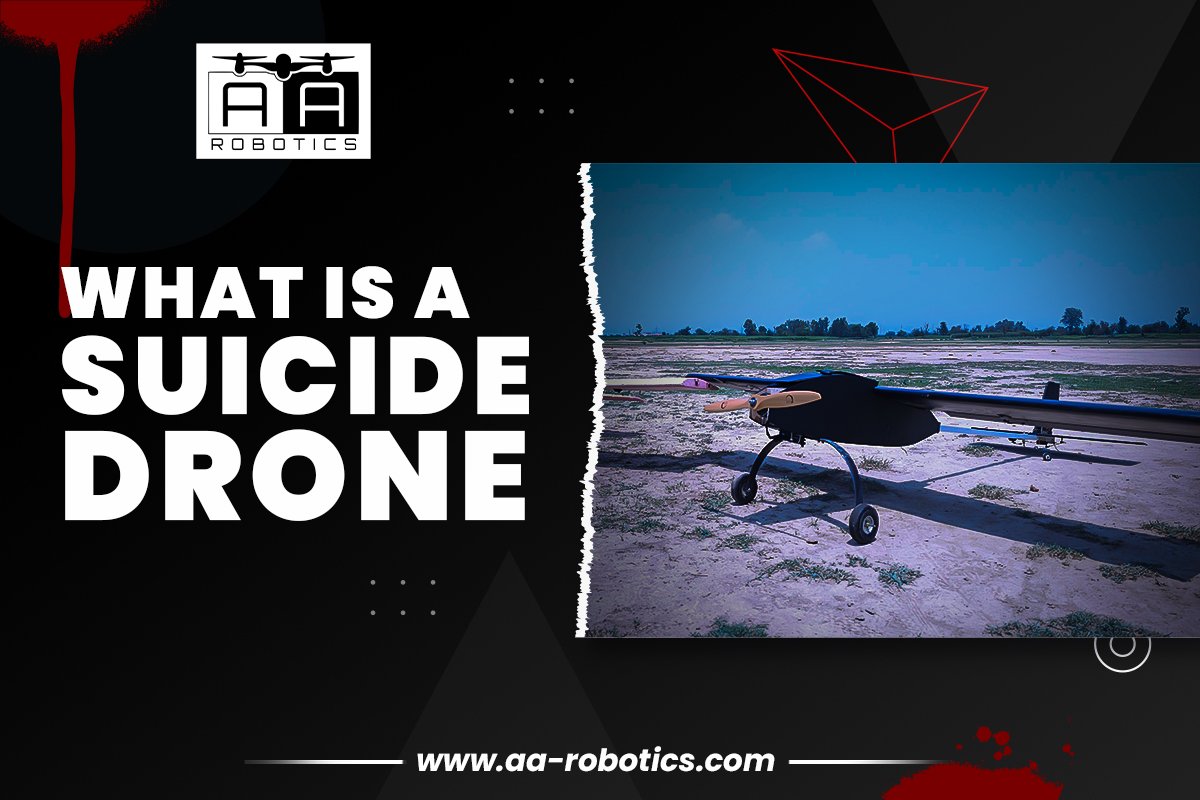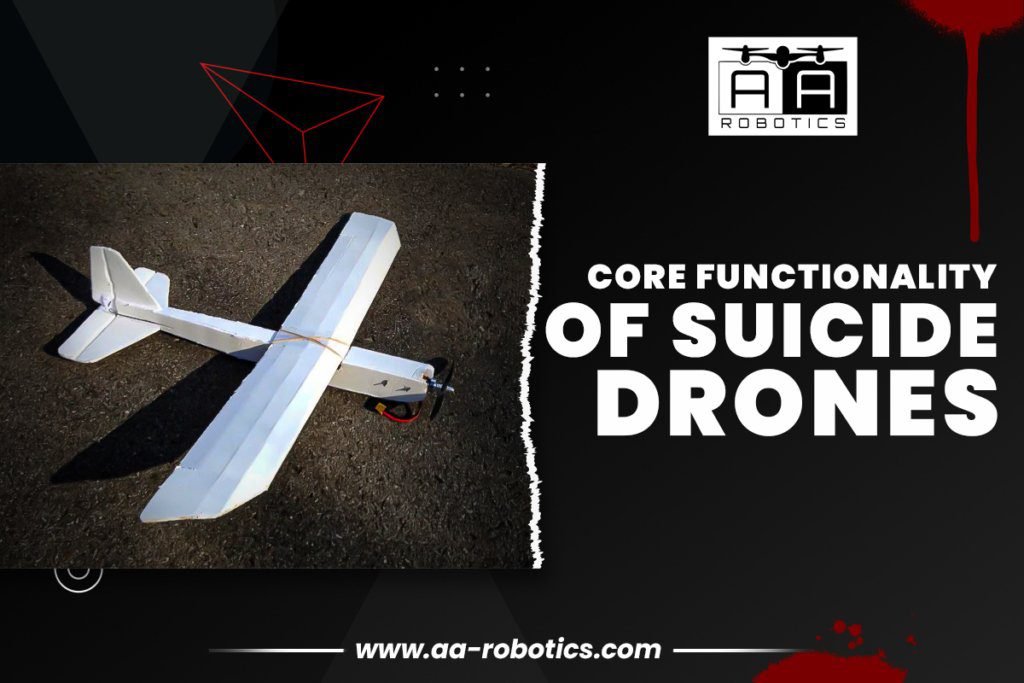
What is a Suicide Drone
Suicide drones, sometimes called loitering munitions, are UAVs that linger over a particular area for an extended period before launching their attack on the intended target. They are unique compared to the drones, which go back to base after the completion of a given mission, as they are built to detonate with impact and eliminate the targeted area as well as themselves. They are a combination of drones and guided missiles, therefore making them a new tool in modern warfare.
This blog by AA Robotics takes a dive into the features, applications, and considerations of suicide drones, keeping in mind their technical aspects and defensive roles.
The Evolution of Suicide Drones
Suicide drones emerged as an innovative solution in the world of modern warfare challenges. This is because other munitions required a clear line of sight or more human influence to hit any target on the ground. Suicide drones revolutionized the way wars were fought through autonomous vehicles that were highly accurate, low-cost, and risky.
- Key Milestones in Developments
Concept / Notion: The notion of a one-way aircraft that would strike high-value targets with accuracy.
Advancements in Technology: Advanced sensors, guide systems, and lightweight materials for better efficiency.
Deployment in Operations: Gradually introduced in different military operations and demonstrated their effectiveness in complicated operations.
Core Functionality of Suicide Drones

Suicide drones work through a carefully designed sequence of phases to optimize the success of a mission while minimizing risks.
Launch and Deployment
Suicide drones can be launched from different platforms, such as ground vehicles, naval ships, or handheld systems. Due to their portability, they can be deployed in a wide variety of operational environments—from open battlefields to urban settings.
Loitering and Surveillance
During this phase, the drone continues to hover over a target area and gathers intelligence by utilizing its onboard cameras and sensors. High-level AI systems will enable autonomous decision-making so that the drone can dynamically respond to the scenario.
Precise Strike
After identifying and locking in the target, it will descend to the target in a controlled manner and detonate upon impact to maximize its effect. This will help reduce unnecessary collateral damage and make the operations more efficient.
The Unique Features of Suicide Drones
The suicide drones have unique features that classify them differently from other unmanned aerial vehicles:
- Compact Design
Lightweight construction with foldable designs makes them portable and easy to deploy in rugged terrains.
- Advanced Surveillance
Enabled with high-resolution cameras, thermal imaging, and multispectral sensors, suicide drones excel in reconnaissance and target identification.
- Cost Efficiency
Suicide drones are often more economical than traditional missile systems, which enables large-scale deployment.
- Stealth and Camouflage
The advanced materials and reduced noise emissions make the drones hard to detect, thus guaranteeing the success of a mission in sensitive operations.
Applications of Suicide Drones
The versatility of suicide drones has expanded their utility across various operational domains:
- Defensive Operations
They have the capacity to build a very solid defence mechanism against vital infrastructure and military forces.
- Surveillance and Inspection
This particular aspect of suicide drones, being loitering in one place for a long period of time, makes it a perfect candidate for getting real-time intelligence gathering from dangerous areas.
- Strategic Strikes
They are able to target high-value assets with precision, thus capable of neutralizing such high-value targets without putting the lives of personnel at risk.
- Disaster Response
In non-combat missions, suicide drones can be used for sending payloads to inaccessible areas during emergencies and even controlled demolitions.
Technological Advancements in Suicide Drones
The process of continuous evolution in technology has greatly improved the features of suicide drones.
- Artificial Intelligence/AI
Application of AI made the drones process an enormous number of data while recognizing many patterns and making decisions about their assignments in real time while executing.
- Sophisticated Guidance Systems
The latest GPS and inertial navigation systems allow targeting in areas with low connectivity and difficult terrain.
- Modular Designs
Modular designs make drones easily customizable, thus able to fit mission-specific payloads or more sensors.
- Renewable Power Sources
Solar panels and fuel cells are also the latest innovations in renewable energy, which will stretch drones’ operational range for increased sustainability.
- Cybersecurity Measures
Since drones increasingly feature in digital warfare, their cybersecurity must be of adequate strength to prevent hacking or other tampering.
Defensive Roles of Suicide Drones
Suicide drones are the essence of modern defence. They provide accuracy and versatility in the face of multifaceted threats. Border security is enhanced, as critical infrastructure is protected from unwanted surveillance, and hostile UAVs are intercepted with unparalleled effectiveness. Because suicide drones can loiter and quickly respond, they are a tremendous asset for both urban and far-flung defence. They go beyond being an immediate tactical resource in showing preparedness and reduce risk to personnel and assets within high-stakes environments.
AA Robotics and Suicide Drone Technology
AA Robotics is at the forefront of UAV technology that provides cutting-edge solutions for the operation of land, air, and sea. Our advanced systems for drones, including our loitering munitions, are made with precision in mind for safety and agility.
AA Robotics is renowned for integrating AI, modular designs, and innovative materials to provide unparalleled products that redefine the standards of modern defence technology.With a focus on sustainability and efficiency, we commit ourselves to providing cutting-edge solutions that can deal with the complexities of today’s security challenges.
Conclusion
In terms of precision, adaptability, and cost-effectiveness, the suicide drone is essentially the state-of-the-art unmanned aerial technology. They promise to have a vital position in the modern defence approaches as the applications unfold.At AA Robotics, we pride ourselves on innovative UAV solutions that can meet a wide range of operational requirements. Quality, safety, and sustainability form the cornerstone of our commitment to providing products that lead the drone technology industry. From reconnaissance and surveillance missions to defensive operations, AA Robotics is your partner of choice in the ever-evolving robotics and UAV industries.
Suicide drones refer to unmanned aerial vehicles designed specifically to linger in an area for some time before hitting a target by causing an explosion in the contact area
Contrary to general drones, suicide drones form one-way systems intended strictly for surgical strikes where these drones make the ultimate sacrifice.
Suicide drones can be utilised for defensive operations, reconnaissance, strategic strikes, and disaster responses.
AA Robotics is providing advanced UAV solutions with a focus on innovation, safety, and efficiency with the perspective of modern-day defence and surveillance needs.
Yes, suicide drones usually feature AI systems that allow them to execute activities independently, such as identifying a target and engaging it.


